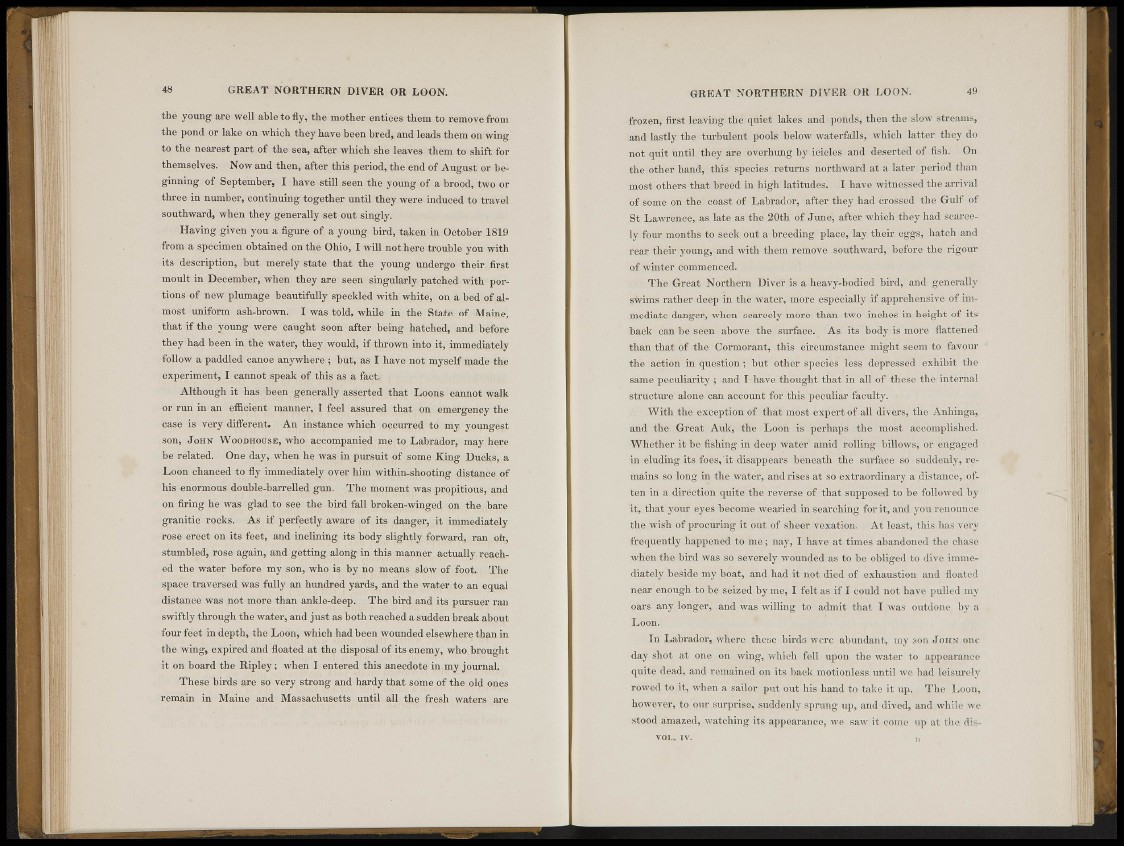
48 GREAT NORTHERN DIVER OR LOON.
the young are well able to fly, the mother entices them to remove from
the pond or lake; on which they have been bred, and leads them <5® wing
to the nearest part of the sea, after which she leaves them to shift for
themselves, Now and then, after this period, the end of August or beginning
of September, X have still seen the young of ,a brood, two or
three in number, continuing together until they were induced to travel
southward, when they generally set out singly.
Having given you a figure of a young bird, taken in Oetober 1819
from a Specimen obtained on the Ohio, I will not here trouble you with
its description, but merely state that the young undergo their first
Moult iti. December, when they are seen singularly, patched <W|th portions
of new plumage beautifully speckled with white, on a bed of almost
uniform ash-brown. I was told, while in the State, of, Maine,
that if the young were caught soon after being hatched, and before
they had been in (he water, they would, if thrown into it, immediately
follow a paddled canoe anywhere;-;- but, as I have Sot myself made the
experiment, I cannot speak of this as a fact.
Although it has been generally asserted that Loons cannot walk
or run in an efficient manner, I feel assured that on emergency thè
case is very different. An instance which occurred to my youngest
son, John Woodhouse, who accompanied pS'tO Labrador, may here
be related. One day,.when he was in pursuit of some King Ducks, a
Loon chanced to fly immediately over him within-shooting distance of
his enormous double-barrelled gun. The moment was propitious, and
on firing he was glad to see the* | i rd fall broken-winged on the. bare
granitic rocks. As if perfectly aware of i||l> danger, it immediately
rose erect on its feet, and inclining its body slightly forward, ran oft,
stumbled, rose again, and getting along in this manner actually reached
the water before my son, who is by no means slow of foot. The
space traversed was fully an hundred yards, and the water to an equal
distance was not more, than ankle-deep. The bird and its pursuer ran
swiftly through the water, and just as both reached a sudden break about
four feet Siiidejth^theLoon, which had been wounded elsewhere than in
the wing, expired and floated at the disposal of its enemy, who brought
it on board the Ripley; when I entered this anecdote in.my journal.
These birds are so very strong ¡and hardy that some of the old ones
remain in Maine and Massachusetts until all the fresh waters are
GREAT NORTHERN DIVER OR LOON. 49
frozen, first leaving the quiot lakes and ponds, then the slow streams,
and lastly the turbulent pools below waterfalls, which latter they do
not quit until they are overhung by icicles ami deserted of fish. On
the other hand, this species returns northward at a later period than
most others that breed in high latitudes.. J í have witnessed the arrival
of some on the coast of Labrador, after they had crossed the Gulf of
St Lawrence, as late as the 20th of Juné, after which they had scarcely
four months to seek out a breeding" place, lay their eggs; hatch and _
rear their 'young, and with them remove southward, before the rigour
of winter commenced.
The Great Northern DiveS is a heaivy-bodied bird, and generally
swims rather deepffefprwater, more ©specially if apprehensive of immediate
danger, whepjSCareely more than two inches in height of its
back can lie seen above the surface. As its body is more flattened
than that of the Cormorant,-this circumstance might seem to favour
the action in question ; but other spectra 'less depressed exhibit the
same peculiarity ; and-T-have thought that in all of these the internal
structuré' aloné can account for this peculiar faculty.
With the exception Of that most expert of all divérs, the Anhinga,
and the. Great Auk, the Loon is perhaps the most accomplished.
Whether it be fishing in deep water amid rolling billows, or engaged
in eluding its foes, it disappears beneath the surface so suddenly, remain*
SO: long in the water, and rises at so extraordinary a distance, often
in a direction jjuitc the reverse of that supposed to be followed by
it, that your eyes become wearied in searching for it, and you renounce
the wish of procuring it out.of sheer vexation. At least, this has very
frequently happened to me ; nay, I have at times abandoned the chase
when the,ib'ird was,so severely wounded as to be obliged to dive immediately
beside my boat, and had it not died of exhaustion and floated
near enough to be seized by me, I felt as if I could not have pulled-my
oars any 'longer, .and.was willing :ft¡>, admit that I was outdone. Jjy a
Loon.,
In Labrador, where these birds were abundant, my son John one
day shot at one . on wing, which fell upon the water to appearance
quité dead, and remained on its'back, motionless until we had leisurely
rowed to it, when a sailor put out his hand to take it up. The Loon,
however,, to our surprise, suddenly sprung up, and dived, and while we
stood amazed, watching its appearance, we saw it come up at the disc